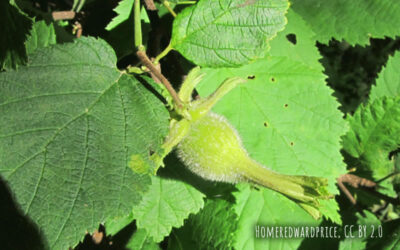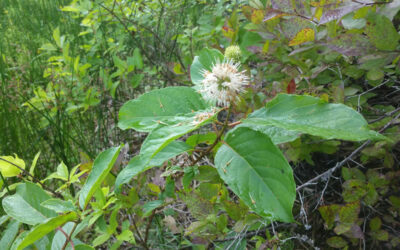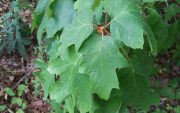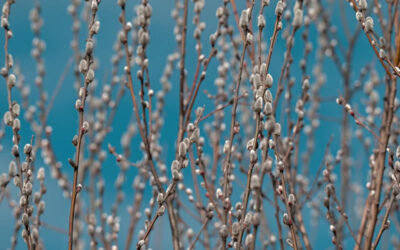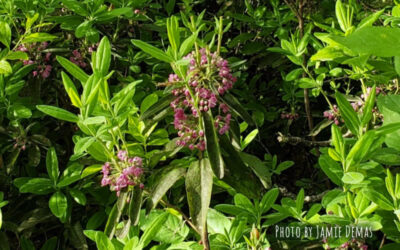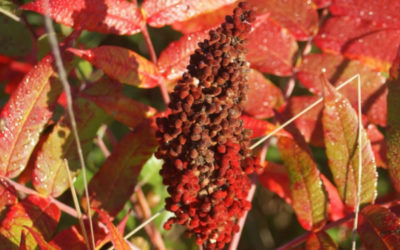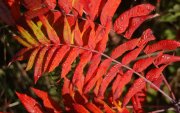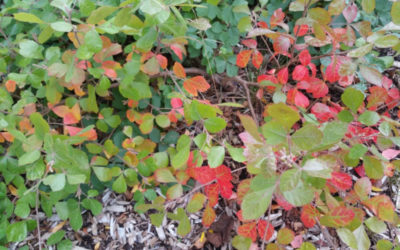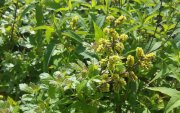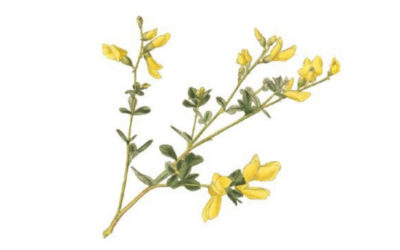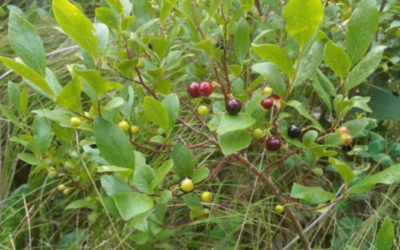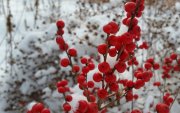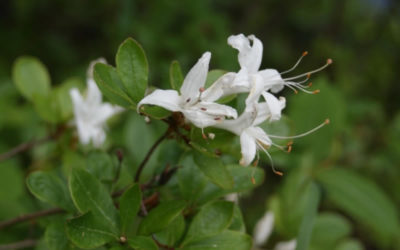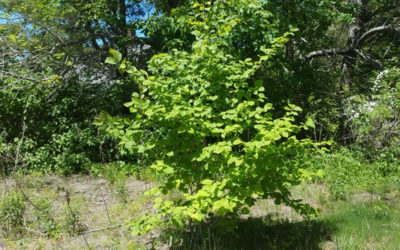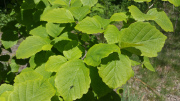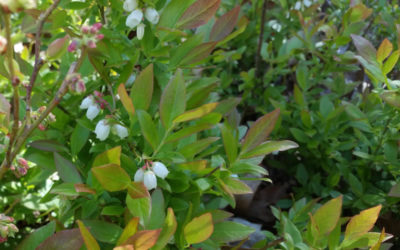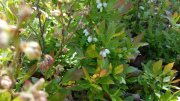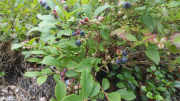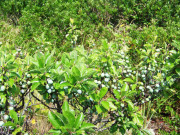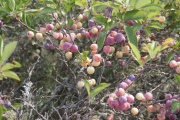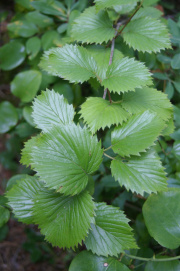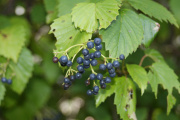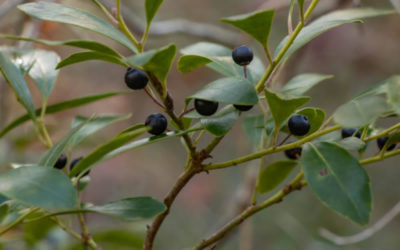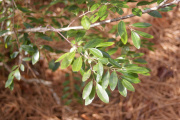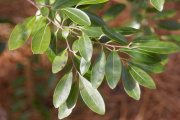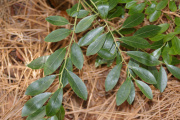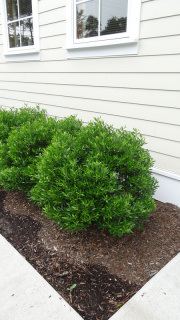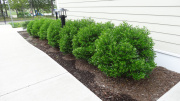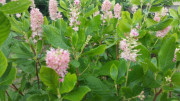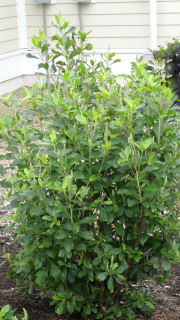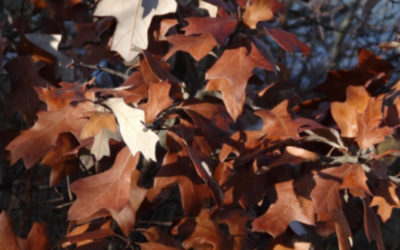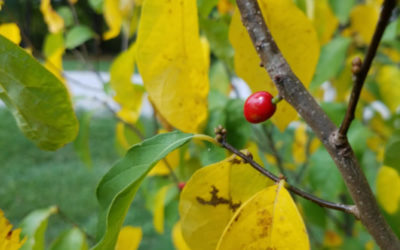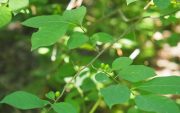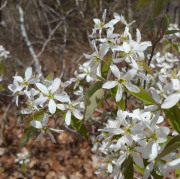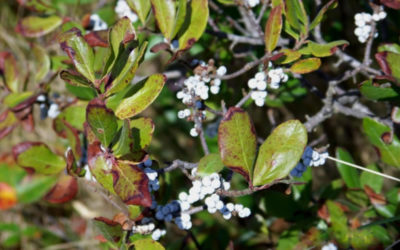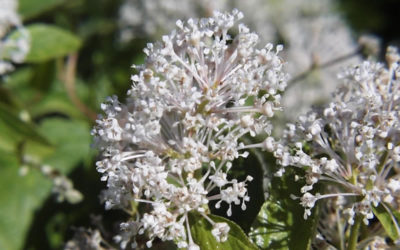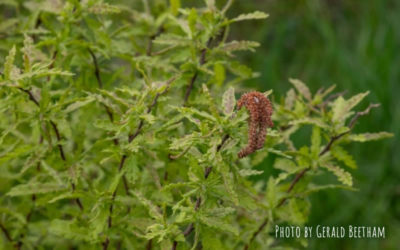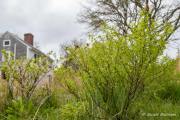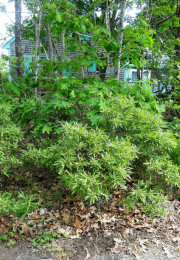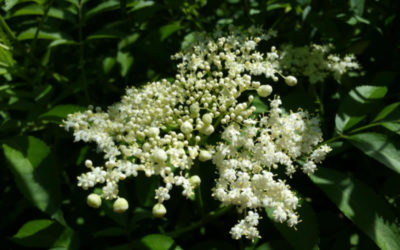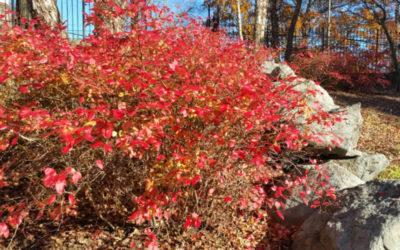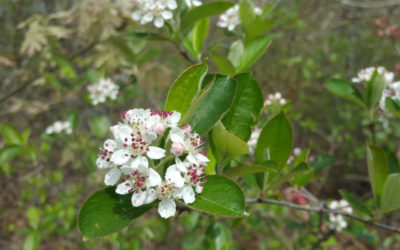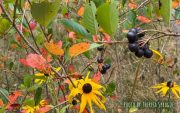Choose the Perfect Plant
This online tool is designed to help you find the native plants best-suited for specific sites that provide the greatest ecological function and benefit, and that will also complement your Cape Cod landscape design. Using the dropdowns below, you have the ability to find plants based on these six criteria: Plant Type, Sunlight, Soils, Bloom Month, Size, and Nature Benefits. Based on your choices, the results will automatically populate.
Beaked Hazelnut
Corylus cornuta
Growing Information
• Plant Type: Shrub
• Sunlight: Full, partial
• Soils: Medium-dry to Moist, well-drained
• Bloom Time: February, March
• Size: 3-8ft tall
A true Cape Cod native shrub. Foliage turns bright yellow in fall. Male catkins appear before the leaves. Flowers are inconspicuous pinky-purple and are wind pollinated. The nuts are enclosed in a husk that extends beyond the nut to form the “beak.” Nuts are a favorite of wildlife. Its long catkins are a welcome sight in the garden in late winter. It is an attractive shrub in a woodland garden.
Garden Companions
Serviceberry (Amelanchier canadensis); Padoga Dogwood (Cornus alterniflora); Ninebark (Physocarpus opulifolius)
Nature Benefits
• Nuts are favorite of wildlife
Natural Habitat
Forests, and forest edges.
Buttonbush
Cephalanthus occidentalis
Growing Information
• Plant Type: Shrub
• Sunlight: Full to part sun
• Soils: Moist to wet soils. Tolerates standing water
• Bloom Time: Mid-Summer
• Size: up to 12 ft
Showy, pom-pom like flowers attract tons of butterflies and hummingbirds. Loves water. Makes an attractive hedge or accent shrub at the edge of a pond or in a marshy area. Flowers mature into button-like fruits filled with seeds which attract ducks and other water birds.
Garden Companions
Winterberry (Ilex verticillata); Blue Flag Iris (Iris versicolor); Cardinal Flower (Lobelia cardinalis); Swamp Milkweed (Asclepias incarnata); Highbush Blueberry (Vaccinium corymbosum)
Nature Benefits
• Provides nectar for native bees, hummingbirds, and butterflies
• Seeds are eaten by ducks and other waterfowl
• Larval host to several species of sphinx moth
Natural Habitat
Marshes, wet meadows, bogs, and pond edges
Oakleaf Hydrangea
Hydrangea quercifolia
Growing Information
• Plant Type: Shrub
• Sunlight: Full sun to part shade or filtered shade
• Soils: Moist, well-drained soils
• Bloom Time: May, June, July
• Size: 6-8 feet.
Perfect size, low maintenance shrub for an informal hedge or as a showy specimen. Shade tolerant. Finely divided leaves reminiscent of oaks, and large white flower spikes persist throughout the season. Fabulous fall color, and the peely bark and dry flowers provide winter interest as well. Great replacement for the ever-popular non-native hydrangeas. Native to southern states but does well in Massachusetts landscapes.
Garden Companions
Southern Magnolia (Magnolia grandiflora); Flame Azalea (Rhododendron calendulaceum); Eastern Redbud (Cercis canadensis); Dwarf Crested Iris (Iris cristata)
Nature Benefits
• Insects overwinter in spent stems.
• Nesting material for birds
Natural Habitat
Moist woods, riverbanks of southern states.
Photo Gallery
Pussy Willow
Salix discolor
Growing Information
• Plant Type: Shrub
• Sunlight: Full sun
• Soils: Moist to wet soils.
• Bloom Time: February, March
• Size: Up to 20ft tall, often shorter. Tolerates being cut back aggressively.
Fast growing shrub. Appreciates being cut back every few years to encourage vigorous new suckering growth. Fuzzy buds appear in late winter and open into sticky catkins which provide nectar and pollen during a crucial time of the year when food is scarce. Beautiful as an accent in cut flower arrangements. Propagates easily from cuttings. BEWARE of non-native hybrids in nurseries – they do not support native insects.
Garden Companions
American Blue-flag (Iris versicolor); Swamp Rosemallow (Hibiscus moscheutos); Marsh Marigold (Caltha palustris); Winterberry (Ilex verticillata)
Nature Benefits
• Provides nectar for native bees very early in the year when food is scarce.
• Larval host to many butterflies and moths, including the Morning Cloak (Nymphalis antiopa), Viceroy (Limenitis archippus), and the Cecropia Moth (Hyalophora cecropia).
• Birds feed on the buds and catkins; twigs are browsed by deer.
Natural Habitat
Marshy, low areas; streambanks and ditches.
Sheep Laurel
Kalmia angustifolia
Growing Information
• Plant Type: Shrub
• Sunlight: Sun, part shade
• Soils: Average, dry or moist
• Bloom Time: Pink flowers in June, July
• Size: 1-3 feet in height; 1-3 foot spread
Adaptable to a variety of sites, plant in naturalized areas, foundation plantings, or woodland gardens. The showy Sheep Laurel is allelopathic, roots exude chemicals that inhibit conifer growth, it is also toxic to many mammals. It may form large evergreen colonies. The flowers are miniatures of Mountain Laurel. Native to Cape Cod.
Garden Companions
Christmas Fern (Polystichum acrostichoides), Wintergreen (Gaultheria procumbens), Sweet Fern (Comptonia peregrina)
Nature Benefits
• Provides winter forage and cover for birds
• Caterpillar host for the White Slant-line and the Mottled Gray Carpet moths
Natural Habitat
Found in forests, shores of ponds and lakes, bogs, and woodlands.
Smooth Sumac
Rhus glabra
Growing Information
• Plant Type: Shrub
• Sunlight: Full Sun, Partial, Shade
• Soils: Medium to dry
• Bloom Time: June, July
• Size: 10-20 feet tall, spread 20 feet
Colony-forming shrub – most noticeable for its brilliant fall color and bright red fruit. The plant is dioecious and only the female plants produce fruit. Sumac is effective where it has room to establish in its natural drift form. Colonies can be rejuvenated by cutting to the ground in mid-winter every few years. Great for dry, tough locations, especially on slopes. Great plant for restoration projects.
Garden Companions
Other species of sumac, Common Ninebark (Physocarpus opulifolius)
Nature Benefits
• Flowers attract pollinators
• Berries provide food for many birds
• Provides wild bees nesting materials and structure for their life cycles
Native Habitat
Occurs in old fields, hardwood forest edges, and dry uplands.
Photos
Fragrant Sumac
Rhus aromatica
Growing Information
• Plant Type: Shrub
• Sunlight: Full Sun, Partial
• Soils: Medium to dry
• Bloom Time: June, July
• Size: 2-6 feet tall, spread 6-10 feet
Good fast growing ground cover for banks and slopes. Can be massed or used in wind breaks. It suckers and roots where stems touch the ground and forms a dense stand. The straight species is usually tall and leggy in a garden setting, but the cultivar ‘Gro-Low’ is useful as a landscape plant for ground cover and stays no higher than three feet. Like all sumacs, it is dioecious, and fruit will only appear on female plants.
Garden Companions
Sweetfern (Comptonia peregrina), Little Bluestem Grass (Schizachyrium scoparium), Oakleaf Hydrangea (Hydrangea quercifolia), Flowering Dogwood (Cornus florida)
Nature Benefits
• Flowers attract pollinators
• Berries provide food for many birds and mammals
• Provides wild bees nesting materials and structure for their life cycles
Native Habitat
Occurs in old fields, hardwood forest edges, and dry uplands.
Photos
Groundsel Bush
Baccharis halimifolia
Growing Information
• Plant Type: Shrub
• Sunlight: Light shade to full sun
• Soils: Sandy to loamy, moist to wet, well-drained
• Bloom Time: August, September, October
• Size: 3-10 feet in height
Also called sea-myrtle or saltbush, inconspicuous flowers give way to fluffy white seed heads that burst open on female plants in the fall months. This shrub is highly salt tolerant and can withstand salt spray and periodic flooding as well as drought, making it a great shrub for coastal landscapes and for use in rain gardens. When the white seed heads pop into view in the fall around our salt marshes, everyone asks, “What is that plant?”
Garden Companions
Rose Mallow (Hibiscus moscheutos)
Nature Benefits
• Erosion control
• Flowers attract pollinating insects
• Dense branches provide shelter for birds and other wildlife
Native Habitat
Occurs naturally along salt marshes edges.
Dwarf Witch Alder
Fothergilla gardenii
Growing Information
• Plant Type: Shrub
• Sunlight: Sun to part shade
• Soils: Well-drained, Average
• Bloom Time: May, June
• Size: 1 to 3 feet in height
A native to the southeastern states, this deciduous shrub does well on Cape Cod. The white fragrant flowers are a mass of stamens that appear before the leaves in brushy terminal spikes. Its dense, dark green, leathery foliage becomes bright yellow to scarlet red for brilliant fall color and is resistant to deer and rabbits. Good for a low hedge, in a mixed shrub planting, foundation planting, or rain garden.
Garden Companions
Sweet Pepperbush (Clethra alnifolia), Low Bush Blueberry (Vaccinium angustifolium)
Nature Benefits
• Attracts bees and butterflies
Native Habitat
Occurs in woods and stream banks in states of the southeast.
Yellow Wild Indigo
Baptista tinctoria
Growing Information
• Plant Type: Shrub
• Sunlight: Full sun to part shade
• Soils: Well-drained average to dry
• Bloom Time: June, July
• Size: 2-3 feet tall with 2-3 foot spread
Yellow wild indigo is also called horsefly weed. It is an upright shrubby perennial with fine textured gray- green leaves and is drought tolerant. In late spring and summer, plants are adorned with many short clusters of bright or creamy yellow pea-shaped flowers. It thrives in harsh conditions and once established is durable and long lived. All Baptisia spp. are nitrogen-fixing legumes. They have a symbiotic relationship with the Rhizobium bacteria that allows them to utilize atmospheric nitrogen.
Garden Companions
Butterfly Milkweed (Asclepias tuberosa), Purple Coneflower (Echinacea purpurea), Black-eyed Susan (Rudbeckia hirta), Showy Goldenrod (Solidago speciosa)
Nature Benefits
• Plants host caterpillars of Frosted Elfin, Wild Indigo Duskywing and Orange Sulfur butterflies as well as the caterpillars of other moths and skippers.
Native Habitat
Occurs in dry meadows, oak barrens, pine barrens, open woods, and fields.
Black Huckleberry
Gaylussacia baccata
Growing Information
• Plant Type: Shrub
• Sunlight: Sun, Part Shade, Shade
• Soils: Dry, moist
• Bloom Time: Spring blossoms – April, May, June
• Size: 1-2 feet in height
Gaylussacia baccata closely resembles the native blueberry plants (Vaccinium species) with which it grows in the same habitats. However, it can be readily identified by the numerous resin dots on the undersides of the leaves that glitter when held up to the light. Flowers are in dangling groups of 3–7, orange or red, bell-shaped. Berries are dark blue to black when ripe. Berries are sweet and tasty. People and animals eat them raw, jellied, or in baked items.
Garden Companions
Lowbush Blueberry (Vaccinium angustifolium), Mountain Laurel (Kalmia latifolia), Sassafras (Sassafras albidum), Wintergreen (Gaultheria procumbens)
Nature Benefits
• The fruit and twigs on this shrub are used by many forms of wildlife and attracts birds.
• Many species of butterflies visit the bell-like flowers for nectar.
Native Habitat
Occurs in dry or moist open woods.
Winterberry
Ilex verticillata
Growing Information
• Plant Type: Shrub
• Sunlight: Sun, part shade, shade
• Soils: Moist, medium wet, medium, dry (once established)
• Bloom Time: White flowers in June
• Size: 6-10 feet in height
Known for its stunning red berries in the late fall over the winter. Like any holly, it is dioecious, and berries are born on female plants provided there is a male plant within about 50 feet. Pollen is carried by the wind. Popular paired cultivars are ‘Jim Dandy’ (male plant grows to 5ft) and ‘Red Sprite’ (female plant matures at 3-4ft).
Garden Companions
Ink berry (Ilex glabra), Arrowwood (Viburnum dentatum), Red Osier (Cornus sericea)
Nature Benefits
• Berries are eaten by many songbirds in the winter.
• In its mature size, provides desirable nesting habitat.
Native Habitat
Occurs at wetland edges, pond edges, and vernal pools.
PHOTOS
Swamp Azalea
Rhododendron viscosum
Growing Information
• Plant Type: Shrub
• Sunlight: Shade, part shade
• Soils: Average, moist
• Bloom Time: White in June, July
• Size: 3-5 feet in height; 3-5 feet spread
Plant Swamp Azalea as a hedge, in a mixed border, native plant garden, or in a foundation planting. The flowers appear after the leaves which have good fall color. It is one of the latest azaleas to bloom and the most fragrant. Its corolla is covered with sticky glands.
Garden Companions
Royal Fern (Osmunda regalis), Cinnamon Fern (Osmundastrum cinnamomeum), Great Blue Lobelia (Lobelia siphilitica), Sweet Pepperbush (Clethra alnifolia), Inkberry (Ilex glabra)
Nature Benefits
• Attracts birds and bumble bees
• Host plant for caterpillars
Native Habitat
Occurs in shores of rivers or lakes, swamps.
Witch Hazel
Hamamelis virginiana
Growing Information
• Plant Type: Shrub
• Sunlight: Sun, part shade, shade
• Soils: Average, wet
• Bloom Time: Yellow flowers in late October, November, December
• Size: 6-15 feet in height; 6-15 foot spread
Witch Hazel works well as a border plant, understory companion or specimen. Its frilly flowers bloom as leaves are dropping in the fall with golden foliage displays. The flowers are aromatic, and the fruit ejects its seeds as far as 30 feet from the parent tree. A Chinese hybrid flowers the wrong time of year, so don’t be fooled – make sure you seek out the straight native species.
Garden Companions
American Holly (Ilex opaca), Maple-leaved viburnum (Viburnum acerifolium), Christmas Fern (Polystichum acrostichoides), Shadbush (Amelanchier canadensis), Pasture Rose (Rosa Carolina), Red Osier Dogwood (Cornus stolonifera), American Hazelnut (Corylus americana)
Nature Benefits
• Birds eat the fruit and seed.
• Caterpillar host to caterpillars of these moths: Bethune’s Pinion, Drexel’s Datana.
Native Habitat
Occurs in floodplains, forests, swamps.
Photos
Lowbush Blueberry
Vaccinium angustifolium
Growing Information
• Plant Type: Shrub
• Sunlight: Full sun, part shade
• Soils: Dry to moist, Average
• Bloom Time: White flowers in May, June
• Size: 1-2 feet in height; 1-3 foot spread
Grow lowbush blueberry in a rock garden or woodland setting. Blueberries are edible and the foliage is attractive and especially vibrant in fall. Thrives in moist, highly organic, well-drained, acidic soil, but can also grow in shady, dry soils that are barren of other plants.
Garden Companions
Mountain Laurel (Kalmia latifolia), Teaberry (Gaultheria procumbens), Christmas Fern (Polystichum acrostichoides), Intermediate Fern (Dryopteris intermedia)
Nature Benefits
• Host plant for the Brown Elfin butterfly.
• Pollen and nectar source for a variety of bees and other insects.
• Offers fruit for mammals and birds.
Native Habitat
Occurs in forest understory, upland bogs, pastures.
Photos
Beach Plum
Prunus maritima
Growing Information
• Plant Type: Shrub
• Sunlight: Sun
• Soils: Dry, average
• Bloom Time: White flowers in April, May
• Size: Size: 3-6 feet in height; 3-6 foot spread
Plant in a sunny, sandy site as a shrub border, wild hedge, foundation planting, or ornamental. Beach Plum provides showy displays of white flowers in spring. Cross pollination is needed to produce the flavorful fruit, which is used to make jams and jellies or feed wildlife. Beach Plum is a rounded, dense, suckering shrub member of the rose family. Drought tolerant. Salt spray tolerant. Does not like to be crowded by other plants. Beach plum is quintessential Cape Cod!
Garden Companions
American Beachgrass (Ammophila breviligulata), Beach Pea (Lathyrus maritimus), Seaside Goldenrod (Solidago sempervirens), Bayberry (Morella pensylvanica), Evening Primrose (Oenothera perennis), Virginia Rose (Rosa virginiana)
Nature Benefits
• Attracts butterflies, moths, birds, and bees.
• Fruit feeds wildlife.
Native Habitat
Occurs in sandy openings near the coast, dunes, meadows, fields.
Photos
Arrowwood
Viburnum dentatum
Growing Information
• Plant Type: Shrub
• Sunlight: Sun, part shade
• Soils: Acidic moist, well-drained, average
• Bloom Time: White flowers in May, June
• Size: 6-10 feet in height; 5-10 foot spread
Upright growing shrub that turns shades of yellow, orange, and red in the fall. It can be used for borders, hedges or screens, or as mass plantings and groupings, foundation plantings, or as a backdrop to a pollinator or wildlife garden. Fruits are dark blue. If you must prune, do so immediately after flowering since flower buds form in the summer for the following year.
Garden Companions
Eastern Wood Fern (Dryopteris marginalis), Lady Fern (Athyrium filix-femina), White Turtlehead (Chelone glabra), Golden Groundsel (Packera aurea)
Nature Benefits
• Attracts Red Admiral, Eastern Comma and Question Mark butterflies
• Host plant providing food for the caterpillar stage of Spring Azure Butterfly and Hummingbird Moth.
• Fruit is food for a variety of songbirds.
Native Habitat
Occurs in forest edges, shady upland woods, and wetland edges.
Photos
Inkberry
Ilex glabra
Growing Information
• Plant Type: Shrub
• Sunlight: Sun, part shade
• Soils: Moist to Average
• Bloom Time: May, June – flowers called cymes are inconspicuous
• Size: 3-8 feet tall, 3-6 foot spread, depending on cultivar
As like other hollies, Inkberry is dioecious: need male pollinator plant to get female fruit set. Berry-like drupes are black and the size of a pea. It’s an upright grower that works well in a hedge and can be pruned. A good native option to boxwood. It is a broadleaf evergreen that is a slow grower.
Garden Companions
Teaberry (Gaultheria procumbens)
Nature Benefits
• Birds and mammals eat the juicy fruit
• Provides nectar for pollinators.
• Host plant for Henry’s Elfin.
Native Habitat
Occurs in low wet woods, sandy sites, edges and openings in forests.
Photos
Sweet Pepperbush
Clethra alnifolia
Growing Information
• Plant Type: Shrub
• Sunlight: Sun, part shade
• Soils: Wet, average
• Bloom Time: White to pinkish flowers in July, August
• Size: 4-8 feet in height; 4-6 foot spread
Plant Sweet Pepperbush where you are able to smell the spicy, sweet scent of its profuse late summer blooms. It can be planted in a mixed shrub hedge or border. Tolerates drought well once established.
Garden Companions
Inkberry (Ilex glabra), Eastern Woodfern (Dryopteris marginalis)
Nature Benefits
• Birds and mammals eat the fruit.
• Flowers attract butterflies, bees, hummingbirds.
Native Habitat
Occurs in seashores, stream banks, wet woods.
Photos
Scrub Oak
Quercus ilicifolia
Growing Information
• Plant Type: Shrub
• Sunlight: Sun
• Soils: Dry, average
• Bloom Time: Insignificant
• Size: 12-20 feet in height
Scrub Oak is also called Bear Oak and is one of the smaller and more gnarled oaks in New England. It recolonizes dry sites that have been repeatedly cut or burned.
Garden Companions
Black Huckleberry (Gaylussacia baccata), Bayberry (Morella pensylvanica), Pitch Pine (Pinus rigida)
Nature Benefits
• Larval host for Sleepy Duskywing and Eastern Buckmoth.
• Attracts large number of diverse insects in stands of Scrub Oaks.
• Acorns are food source for wildlife.
Native Habitat
Occurs in disturbed areas, woodlands, dry sandy barrens.
Spicebush
Lindera benzoin
Growing Information
• Plant Type: Shrub
• Sunlight: Sun to shade
• Soils: Wet, average
• Bloom Time: Yellow flowers in April, May
• Size: 6-12 feet in height; 6-12 foot spread
Plant in naturalized woodland gardens with both male and female plants for showy red berry production. Fast-growing shrub in moist, shady areas. Some sun yields better form and berries. Dazzling yellow foliage in fall.
Garden Companions
Bloodroot (Sanguinaria canadensis), Christmas fern (Polystichum acrostichoides)
Nature Benefits
• Host plant for Spicebush Swallowtail butterfly, Promethea silkmoth
• High wildlife value for songbirds, butterflies, and small mammals.
Native Habitat
Occurs in low deciduous woods, stream banks, swamps.
Photos
Shadbush
Amelanchier canadensis
Growing Information
• Plant Type: Shrub
• Sunlight: Sun, part shade
• Soils: Acidic moist, well-drained, average
• Bloom Time: White flowers in April, May
• Size: 10-18 feet in height; 5-10 foot spread
Also called Serviceberry, it is good for height in mixed borders or foundation plantings. Called shadbush because its spring flowers coincide when the herring and shad are running. Good fall color. Drought tolerant. Deer and rabbit resistant. Birds love the fruit.
Garden Companions
Pasture rose (Rosa Carolina), American Hazelnut (Corylus americana), Bayberry (Morella caroliniensis)
Nature Benefits
• Host plant for larvae of tiger swallowtail, viceroy, admiral, and striped hairstreak butterflies
• Fruit feeds at least 40 bird species
• Pollinator powerhouse
Native Habitat
Occurs in forest edges, upland woods, meadows and fields.
Photos
Bayberry
Morella caroliniensis
Growing Information
• Plant Type: Shrub
• Sunlight: Full sun to partial shade
• Soils: Moist to dry
• Bloom Time: Inconspicuous flowers appear in early spring- May
• Size: 5-10 feet in height
Ubiquitous on Cape Cod, it is adapted to the Cape’s poor soils and salt spray. Does well in drought and deluge. The leaves are aromatic when crushed. Bayberry is dioecious, being there are male and female plants, and it is the female plant that bears the berries. Makes a good backdrop to a garden.
Garden Companions
Beach Plum (Prunus maritima), Pitch Pine (Pinus rigida), Scrub Oak (Quercus ilicifolia)
Nature Benefits
• Berries are important food for birds.
• The foliage provides cover for birds.
• It has nitrogen-fixing microbes associated with its roots and therefore improves nutrient value of soils for other plants.
Native Habitat
Occurs in dunes, fields, forest edges, roadsides, coastal banks, beach edges.
New Jersey Tea
Ceanothus americanus
Growing Information
• Plant Type: Shrub
• Sunlight: Full sun to partial shade
• Soils: Well-drained, moderate to dry
• Bloom Time: White flowers in June, July, August
• Size: 2-3 feet in height; 2-3 foot spread
This low growing shrub can serve as ground cover or as a tidy, fragrant, blooming shrub to attract bees and butterflies. Once established, its deep roots make it drought tolerant but difficult to move. Plant may die back in winter but will return in spring.
Garden Companions
Pasture Rose (Rosa carolina), False Indigo (Baptisia australis)
Nature Benefits
• Host plant for the caterpillars of the Spring Azure, Summer Azure, and Mottled Duskywing.
• Offers nectar for a variety of pollinating insects and hummingbirds.
Native Habitat
Occurs in dry fields and roadsides, woodland edges.
Photos
Pasture Rose
Rosa carolina
Growing Information
• Plant Type: Shrub
• Sunlight: Sun, part shade
• Soils: Average to wet
• Bloom Time: Showy pink flowers in June, July, August
• Size: 2-4 feet in height; 3-4 foot spread
Plant the low maintenance native rose shrub in borders, mass plantings, and use for naturalizing in spots with good air circulation. Most prolific in full sun. Drought tolerant and deer and rabbit resistant. The rose hip turns bright red as it ripens. It’s also called the Carolina Rose.
Garden Companions
Sweet fern (Comptonia peregrina), Little bluestem grass (Schizachyrium scoparium), Black-eyed Susan (Rudbeckia hirta), Wild geranium (Geranium maculatum)
Nature Benefits
• Offers nectar for bumble bees and other native bees.
• Native bees nest beneath, within, or harvest parts to construct their nests.
• Rosehips support birds in winter.
Native Habitat
Occurs in sandy areas, thickets, roadsides, open woods.
Photos
Sweet Fern
Comptonia peregrina
Growing Information
• Plant Type: Shrub
• Sunlight: Sun, part shade
• Soils: Sandy, acidic, dry to moist
• Bloom Time: Inconspicuous yellowish green flowers in April, May, June
• Size: 1-3 feet in height; 4-8 foot spread
Plant the nitrogen-fixing shrub as a ground cover for erosion control, foundation planting, mixed border, or massing. Colony forming, little management is needed. Fern-like leaves smell sweet and are deer resistant. Nice fall color.
Garden Companions
Bayberry (Myrica pensylvanica), Beach Plum (Prunus maritima), Wild Bergamot (Monarda fistulosa)
Nature Benefits
• Larval host for several sphinx moths, gray hairstreak butterfly, and others.
• Nutlets attract butterflies and birds.
Native Habitat
Occurs in clearings, pastures, edges of bog roads, and woodlands.
Photos
American Elderberry
Sambucus nigra L. ssp. canadensis
Growing Information
• Plant Type: Shrub
• Sunlight: Sun to part shade
• Soils: Wet to dry
• Bloom Time: White flowers in May, June, July
• Size: 5-8 feet in height; 3-8 foot spread
Plant this native as a hedge or alone. Berries and flowers are edible, but other parts of the plant contain toxic calcium oxalate crystals and are poisonous. Individual plants are short-lived, but root masses produce new shoots. Fast grower. Notice the white flowers on wild elderberry along wetland edges in late spring—it loves the Cape’s acidic soils.
Garden Companions
Shadbush (Amelanchier canadensis), American Hazelnut (Corylus americana)
Nature Benefits
• Fruit attracts birds who then spread seeds.
• Berries relished by mammals.
• Attracts pollinators.
Native Habitat
Occurs in alluvial forests, bogs, ditches, drier old fields.
Photos
Highbush Blueberry
Vaccinium corymbosum
Growing Information
• Plant Type: Shrub
• Sunlight: Sun – Shade
• Soils: Moist to dry
• Bloom Time: White flowers in May, June
• Size: 3-12 feet in height; 3-7 foot spread
Highbush Blueberry is excellent for naturalized landscaping. Provides brilliant red fall color and is a great alternative to the harmful invasive Burning Bush.
Garden Companions
Mountain Laurel (Kalmia latifolia), Teaberry (Gaultheria procumbens)
Nature Benefits
• Host to the Frosted Elfin butterfly.
• Berries highly favored by numerous bird species and other wildlife.
• Excellent pollinator plant.
Native Habitat
Occurs in wooded and open areas, wetland edges, dry pitch pine and oak woodlands.
Black Chokeberry
Aronia melanocarpa
Growing Information
• Plant Type: Shrub
• Sunlight: Sun, Part Shade
• Soils: Moist to dry, average
• Bloom Time: White flowers in May, June
• Size: 3-10 feet in height; 3-6 foot spread
Plant this multi-stemmed shrub in a wildlife or mixed shrub border to show its small masses of flowers followed by showy fruit. When planted in full sun, foliage will be deep red in fall. It can spread by root suckers forming colonies. Drought tolerant once established and tolerates occasional flooding.
Garden Companions
Cinnamon Fern (Osmundastrum cinnamomeum), Royal Fern (Osmunda regalis), Steeple Bush (Spirea tomentosa), Speckled Alder (Alnus incana), Wild Strawberry (Fragaria virginiana), Grass-leaved Goldenrod (Euthamia graminifolia)
Nature Benefits
• Showy fruits attract birds in winter.
• Offers nectar for bees and other pollinating insects.
Native Habitat
Occurs in bogs, wet thickets, margins of ponds and lakes, woods.

